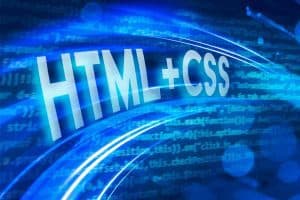HTML CSS Javascript is three different programming languages that web developers use to build a website. These three languages are the foundation of web development. Let me provide a brief overview for those who may be new to web development or unfamiliar with these terms.
HTML (Hypertext Markup Language) is the classic markup language. It can create the structure and content of web pages. CSS (Cascading Style Sheets) makes the style and layout of a web page. It includes fonts, colors, and positioning. JavaScript is a programming language that adds interactivity and dynamic behavior. For example, animations, form validation, and user interface controls.
Why are HTML, CSS, and JavaScript so important? Simply put, they are the building blocks of the web. Every website you visit is built using these three technologies. HTML, CSS, and JavaScript work together to create the web experience we all know and love.
What Is Web Development?
Web development is the process of building and maintaining a website project and web applications. It involves designing and programming skills. There are two primary parts of web development. Front-end and back-end development. Front-end development involves the creation of UI. Back-end development involves the creation of server-side code. Web developers use a variety of tools. They use it to create a beautiful and responsive website. If you are a beginner, you can learn web development from various resources.
What Is a Programming Language?
A programming language is a formal language. We use it to communicate with computers and other machines. It is used to write instructions or code that tell the computer what to do.
Programming languages are designed to be read and written by humans. It is translated into machine code. A computer can execute it. The process of translating a program written in a programming language into machine code is known as compilation or interpretation. The primary coding languages are HTML CSS and Javascript. There are some other programming languages too.
The Basics of HTML
HTML, or Hypertext Markup Language, is a fundamental language. It is used in web development to create and structure a web page. HTML provides the building blocks of a website. It allows developers to create a web page with text, images, and other elements. We’ll cover the basics of HTML, including its syntax and structure, and common HTML tags. You will find the best practices for writing clean and semantic HTML code.
HTML Syntax and Structure
HTML documents are made up of a sequence of elements. Each of these is enclosed in a pair of tags. Tags are enclosed by angle brackets (< >). It typically comes in pairs, with the opening tag preceding the content and the closing tag following it. For example, the basic structure of an HTML document includes the following tags:
<!DOCTYPE html>
<html>
<head>
<title>Page Title</title>
</head>
<body>
<h1>Heading 1</h1>
<p>Paragraph</p>
</body>
</html>
This code includes several different tags. It includes the ‘<!DOCTYPE html>’ declaration. That specifies the version of HTML being used, as well as the ‘html’, ‘head’, ‘title’, and ‘body’ tags. The HTML tag encloses the entire document. On the other hand, the ‘head’ tag contains information about the document. For example, the page title. You will find the content of the page in the ‘body’ tag. The ‘h1’ and ‘p’ tags define a heading and paragraph, respectively.
Common HTML Tags and Their Uses
There are dozens of HTML tags available. Each of these serves a specific purpose in creating a web page. Some common tags include:

HTML tags
- ‘<h1>’, ‘<h2>’, ‘<h3>’, etc.: Defines headings
- ‘<p>’: Defines a paragraph of text
- ‘<a>’: Defines a hyperlink
- ‘<img>’: Inserts an image into the page
- ‘<ul>’, ‘<ol>’, ‘<li>’: Defines lists of items
- ‘<div>’, ‘<span>’: Defines containers for other content
Tips for Writing Clean and Semantic HTML Code
When writing HTML code, it’s important to follow best practices to ensure that your code is clean, well-structured, and semantically meaningful. Some tips for writing good HTML code include:
- Use indentation to make your code easier to read
- Use descriptive class and ID names to make your code more readable and maintainable
- You can use semantic HTML tags to provide meaning and structure to your content
- Use lowercase for all HTML tags and attributes to ensure consistency
- Use quotes around attribute values for clarity and consistency
Learn What is CSS and Its Use
Cascading Style Sheets, or CSS, is a language used in web development to style and lay out web pages. CSS allows developers to control the visual presentation of HTML elements. That includes their color, font, size, and positioning. You will learn the basics of CSS. It involves syntax and rules, selectors and specificity, and common CSS properties. In CSS, you will learn some fairly advanced concepts like CSS rule conflict resolution.
To learn CSS, you can find many tutorials online. There are many free online courses. In some tutorials, you will find the full stack development. So that, you can create a fully functional web application and become a web developer.
CSS Syntax and Rules
CSS is written using a series of rules, each of which consists of a selector and a set of properties. The selector identifies the HTML element(s) to which the rules should be applied. Properties define the visual style of those elements. For example, the following CSS rule sets the color of all text on a web page to “red”:
body {
color: red;
}
In this example, ‘body’ is the selector, while ‘color’ is the property being set to ‘red’. The curly braces ‘{ }’ enclose the set of properties being applied to the selector.
Selectors and Specificity
CSS selectors are used to target specific HTML elements or groups of elements. Selectors can be based on various attributes of an element. It involves its tag name, class, ID, or relationship to other elements. For example, the following CSS rule targets all paragraphs with the class ‘intro’:
p.intro {
font-size: 18px;
}
In this example, ‘p.intro’ is the selector, which targets all paragraphs with the class ‘intro’. The ‘font-size’ property is then set to ’18px’.
CSS specificity determines which style rules should be applied to an element. Many rules target the same element. Specificity is based on the number of selectors, type of selectors, and inline styles applied to an element. When two or more rules have the same specificity, the rule that appears last in the CSS file is applied.
Common CSS Properties and Their Uses
There are dozens of CSS properties available. Each of these controls a specific aspect of an element’s appearance. Some of the most common CSS properties include:

Css tags
- ‘color’: sets the color of the text
- ‘font-size’: sets the size of the text
- ‘background-color’: sets the background color of an element
- ‘border’: sets the border around an element
- ‘margin’: sets the space outside an element
- ‘padding’: sets the space inside an element
Tips for Writing Efficient and Maintainable CSS Code
When writing CSS code, it’s important to follow best practices to ensure that your code is efficient, maintainable, and scalable. Some tips for writing good CSS code include:
- Use a consistent naming convention for your classes and IDs
- Group related styles together to improve readability and maintainability
- Use shorthand properties to cut the amount of code needed
- Use external style sheets to keep your code separate from your HTML
- Cut the use of ‘!important’ declarations to avoid specificity issues
- Use comments to document your code and make it easier to understand and maintain
Javascript and Its Syntex
JavaScript is a dynamic programming language. Developers use it to create interactive websites and web applications. To add functionality to a web page we commonly use JavaScript. For example, validating form input, creating animations, and responding to user events.
JavaScript Syntax and Data Types
JS code is written using a series of statements. That performs a specific action. Statements can include variable declarations, function calls, loops, and conditionals. JavaScript also supports a variety of data types. That includes numbers, strings, booleans, objects, and arrays. It can be used to manipulate web page components.
Variables, Loops, and Conditionals
JavaScript variables are used to store data values. Numbers, strings, or objects are the data values. Variables can be declared using the ‘var’, ‘let’, or ‘const’ keywords. Loops are used to iterate over a set of data. Conditionals are used to perform different actions depending on a specified condition. Some common JavaScript loops and conditionals include:
‘for’ loop: iterates over a specified number of iterations
‘while’ loop: iterates while a specified condition is true
‘if…else’ statement: performs one action if a condition is true, and another action if the condition is false
Functions and Event Handling
JavaScript functions are reusable blocks of code that perform a specific task. Functions can be called multiple times with different inputs to produce different outputs. Functions can also be used to handle user events, such as mouse clicks or keyboard input. Some common JavaScript functions and event handlers include:

- ‘addEventListener’: adds an event listener to an HTML element
- ‘setTimeout’: executes a function after a specified amount of time has elapsed
- ‘parseInt’: converts a string to an integer
Tips for Writing Effective and Reusable JavaScript Code
When writing JavaScript code, it’s important to follow best practices to ensure that your code is effective, reusable, and maintainable. Some tips for writing good JS code include:
- Use meaningful variable names to improve readability and maintainability
- Break down complex tasks into smaller functions to make your code more modular
- Avoid global variables to prevent conflicts and maintain the scope
- Use the ‘strict’ mode to enforce stricter JavaScript syntax rules
- Use comments to document your code and make it easier to understand and maintain
How to Create a Webpage Using HTML CSS and Javascript
When you learn all the languages, you can create a web page. For example, if you want a static restaurant site ready to serve, you have to combine CSS HTML, and Javascript. To create a web page, you need to follow some steps. For your help, we have described the steps below:
Plan Your Content
Everything needs a perfect plan. A perfect plan can solve the work by 50%. So, make a plan before creating a web page. Select the content type and make a sketch of it. Experts can help you create the structure and implement modern web pages. When you have finished with the structure and planning, you can move to the next step now.
Create Your HTML File
The next step is to create an HTML file. For that, you will need a notepad. You will find many notepads online. Open the notepad and start writing HTML codes. Add the structure of the document. When you finish it, save it with .HTML extension. For the structure, you will find many free HTML templet. You can use one.
Add Content to Your HTML File
Once you make a structure of the HTML file, you need to put the content in the ‘body’ section. That will show your content to the entire page. In your content, you can use heading tags like ‘<h1>’, ‘<h2>’, etc. You can also add a paragraph using the tag ‘<p>’.
Add CSS Styling
CSS makes the content look great. To add CSS to your HTML file, simply create a CSS file and save it with a .CSS extension. You can use your own CSS code in the file. When you save it, you can link it with the HTML file. Use the ‘<link>’ tag to link the files.
Add JavaScript Functionality
You can use Javascript language features for your content. Create a new file and save it with .JS extension. You can link your Javascript file with your HTML file. Use the ‘<script>’ tag for that. Javascript adds functionality to the content. In your JavaScript file, write functions to add interactivity to your page.
Advanced Topics in HTML, CSS, and JavaScript Language
Web development has become more sophisticated. You need the tools and techniques to create a page. Besides the basics of HTML, CSS, and JavaScript, web developers must be familiar with advanced topics. It will allow them to create pages that are responsive, modular, and accessible to all users.
Responsive Design and Media Queries in CSS

Responsive Design and Media Queries in CSS
People use to access the web with a wide range of devices and screen sizes. Creating a page that can adapt to different display sizes is important. This is where responsive design comes in. Responsive design is a technique that uses CSS media queries to adjust the layout and styling of a web page. Responsive design ensures that the page looks great in modern web browsers. It also ensures that the size fits the user’s screen.
To implement responsive design, you’ll need to use CSS media queries. It defines styles for different screen sizes. You can specify different styles for different breakpoints. That are the points at which the layout changes. For example, you might have one set of styles for screens smaller than 600 pixels wide. Another set of styles for screens between 600 and 900 pixels wide. A third set of styles for screens wider than 900 pixels.
Object-Oriented Programming and Modular Code in JavaScript
It’s no secret that JavaScript is an effective programming language. It may use to develop everything from basic scripts to sophisticated apps. Object-oriented programming is a key idea in JavaScript (OOP). OOP refers to a way of developing software. Information is stored and manipulated as objects.
Constructor functions and object literals allow for the creation of objects in JavaScript. Objects’ attributes and operations can extend. You may accomplish it using either dot notation or square bracket notation. With OOP, you may write reusable, extensible modules of code.
Browser Compatibility and Cross-Browser Testing
When a website is being developed, special attention is paid to how it displays across various browsers. This is a really difficult task. There are variations in how HTML, CSS, and JavaScript are implemented among browsers. In some cases, this can alter the way a page appears. In extreme circumstances, it may even shatter.
It is important to check if your pages are compatible with one other. You should test it with a variety of browsers and versions. With the help of services like BrowserStack and Sauce Labs automating you may do your browser compatibility test. You should also know how various browsers work, as well as their restrictions. This may be achieved with the use of feature detection and progressive enhancement methods.
Tips for Designing and Structuring a Web Page
Keep It Simple: Do not add too much content to the web page. It will jumble the whole work. Keep it simple and straight structure. It will help to increase user interaction.
Use a Grid System: You can use a grid system in your content. A grid system will help you to make you align the components simply and easily. It will balance the design also. Bootstrap and CSS have the essential grid system.
Use Consistent Styling: Keep the consistency of the web page. For example, you can use the same color, font, and structure in a restaurant web site.
Use White Space: As a web page coder, you can use white space in your content. Using white space will make your content more appealing like a real web site. It will break down the paragraphs and make them eye soothing.
Test Your Web Page: When you finish creating the page, you need to test it. You can test the page on different devices. You must check it on a mobile device for responsiveness.
There are some common designs and layouts you can try. These are:
- One-Column Layout
- Two-Column Layout
- Three-Column Layout
- Hero image Layout
Conclusion
HTML CSS and Javascript are the basic programming languages. With very basic knowledge, you can build a beautiful website. Learning these three languages is the primary condition to become a web developer. Developers use markup languages to build the structure of a website. With CSS coding, they bring style into it and Javascript brings functionality.
It is important to make the website a responsive one. With the help of some basic tools, you can do it. You can join any courses to learn web development. When you start it, You will know about the back end development. You will know the use of python in web development. So, learn HTML CSS, and Javascript and jump to build your website.
